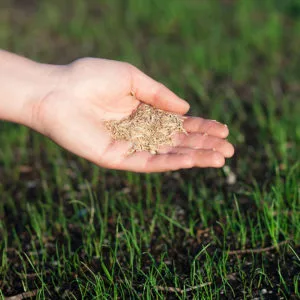Warmer weather is on its way, but winter often leaves behind a lackluster lawn. While fall is the preferred time to toughen up turf with extra grass seed, your lawn sometimes requires a little help in spring to get back to a greener state. Here’s what you need to know about spring grass seeding techniques to fix winter damage.
Preparation
Spring grass seeding is best performed early in the season when temperatures are between 60F and 75F. At this time, soil is at the best temperature for germination of cool-season grass seeds. Properly prepare the area before seeding.
First, identify the type of grass in your lawn in order to purchase the right kind of seeds. Cool-season grasses are common in the northern areas of the United States, while warm-season grasses usually grow best in the southern states. When in doubt, ask a lawn-care expert.
Is your soil healthy enough to encourage new grass growth? Check its pH levels using a soil testing kit to determine what soil amendments need to be applied, if any. Seeds germinate best when soil pH is somewhere between 6 and 7-½, a neutral number on the acidity/alkaline scale.
Spring Grass Seeding Techniques
Now that you’ve done the prep work, you’re ready to determine what technique of spring grass seeding your lawn requires: spot seeding, overseeding, or a complete replacement. When only a few bare or thinning patches of lawn need a little help, spot seeding is all that’s required. This involves sprinkling seed on small areas, as the name “spot seeding” suggests.
If more than a few spots of damaged grass exist or damage is more extensive, overseeding is the way to go. The process of covering an existing lawn with a fresh layer of seed, overseeding fills in thinning areas and contributes to the overall health of the turf.
Lawn replacement, the most labor-intensive of the techniques, is the complete removal of the old turf before putting down new seed. It requires the use of a sod cutter, a machine that removes strips of grass with the roots attached. Another method is to spray the entire lawn with a non-selective herbicide. This chemical kills the grass, but it also kills any other plants it touches, so use with care. More than one application may be required.
Let Us Green up Your Grass
Winter puts plenty of wear and tear on your turf. Give your grass a helping hand in recovery, or let us do it. Call Free Spray Lawn Care at 419-529-5296 and we’ll get your lawn looking healthy and lush for the warmer weather ahead.



Comments (0)
Thanks for your comment!
Thanks for your feedback! Your comments have been successfully submitted! Please note, all comments require admin approval prior to display.
Error submitting comment!
There is a problem with your comment, please see below and try again.